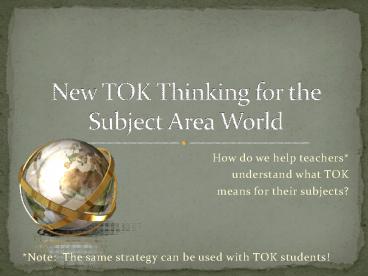How do we help teachers* - PowerPoint PPT Presentation
1 / 21
Title:
How do we help teachers*
Description:
How do we help teachers* understand what TOK means for their subjects? *Note: The same strategy can be used with TOK students! All handouts, PPTs, and lesson ... – PowerPoint PPT presentation
Number of Views:98
Avg rating:3.0/5.0
Title: How do we help teachers*
1
New TOK Thinking for the Subject Area World
- How do we help teachers
- understand what TOK
- means for their subjects?
- Note The same strategy can be used with TOK
students!
2
Where can you get more handouts?
- All handouts, PPTs, and lesson materials are
available NOW on my website. - http//home.comcast.net/cphenlymbk2006/
- If you have my business card, you have the URL.
3
Scroll Down
4
(No Transcript)
5
The Foundation for Critical Thinking
6
The Logic of Science
- Packet page 1
7
The Logic of Ethics
- Packet page 2
8
The Logic of Any Subject Area
- Packet page 3-4
- Structural Framework
- Metacognitive
- TOK-type considerations
- Interactive (not passive)
9
Samples Available on Website p. 13
- Blank Chart for use with students and teachers
- Philosophy sample prepared by Carolyn Henly as a
model (packet p. 5-6) - Literature sample written by IB and Pre-IB
teachers - World Languages sample written by IB and Pre-IB
teachers - Social Studies sample written by IB and Pre-IB
teachers - Natural Science sample written by IB and Pre-IB
teachers - Three History samples produced by students
10
Revised Framework
- Packet page 7-8
- Tailored for TOK
- More specific
- Breaks concepts down into smaller units
Your Turn!
11
Student Assessments of this Version
- I thought this version was simpler and enforced
the concepts in smaller portions so I think this
version will be easier to understand and study
from than the older version.--Navid
12
Student Assessments of this Version
- The Values reflected in the purpose was really
hard. I was very confused about the questions
box. Is it questions that a person studying
mathematics or history should be asking or just
general questions about the Area of Knowledge.
--Nam
13
Student Assessment of this Version
- One thing that I liked about the new one, is
that it takes into account the values reflected
through the nature of the area of knowledge both
in its purpose and its mechanisms for making
knowledge. Also, I think it is very thoughtful
that you placed a spot for Barriers to
certainty and right below it, the mechanisms
for making knowledge designed to overcome
barriers. I think that strategy will help
students understand the what are the processes/
methods for making knowledge? as part of the
three essential questions for all areas of
knowledge.
14
Student Assessment of this Version
- Not only that, but by placing the keyword to
overcome barriers it makes it clear to students
that knowledge CAN be made even when there are
limitations for making knowledge, otherwise we
would not have to study those areas of knowledge
in school. I know that as we studied some areas
of knowledge, I was very confused, due to
numerous limitations pointed out for making
knowledge, about whether we could make any real
valuable knowledge at all, especially in the
Arts. --Diego
15
Samples Available on Website p.14
- Blank Chart for two-subject comparison
- Sample Two-Subject comparison chart (Natural
Science and Ethics) prepared by Carolyn Henly - Two Sample Two-Subject comparison charts
(Mathematics and History) prepared by students
- Blank Chart for One Subject
- Sample One-Subject Chart (Natural Science)
prepared by Carolyn Henly (packet p. 9-10) - Sample One-Subject Chart (History) prepared by a
student
16
Possible Related Activities Faculty
- Comparison-contrast of subject areas
- Discussion of different versionshave teachers
work in groups to develop a version that they
agree upon (this requires justification, even if
they cannot eventually complete the task)
- Revisit the chart at the beginning of each year
for refining and review - Use of ideas on the chart for lesson-planning
(this is particularly easy in terms of the
identification of important questions and
concepts) - Provide teachers with copies of student-made
charts
17
One Use for Teachers
- Packet page 11-12
18
Possible Related Activities Student
- Pre- and Post-unit reflection
- Comparison-contrast of subject areas for students
- Discussion of different versionshave students
work in groups to develop a version that they
agree upon (this requires justification, even if
they cannot eventually complete the task) - Use of completed charts as review for TOK
presentation and essay
19
TOK Course Companion
20
Presentation Prepared by
- Carolyn P. Henly
- Meadowbrook H.S.
- 4901 Cogbill Rd.
- Richmond, VA 23234
- 804-743-3683
- Carolyn_henly_at_ccpsnet.net
- http//home.comcast.net/cphenlymbk2006
21
The End































